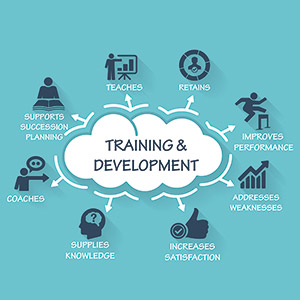Imagine having a team that’s constantly growing, improving, and smashing its goals. Sounds like a dream, right?
This isn’t just a fantasy; it’s a reality you can achieve through effective training and development in human resource management. You hold the key to unlocking your team’s full potential, and this article will show you how. Discover the secrets to transforming your workforce into a powerhouse of talent and productivity.
Ready to take your team’s performance to the next level? Let’s dive in and explore the strategies that can make it happen.
Table of Contents
ToggleImportance of Training and Development
Credit: www.keka.com
Training and development boost employee skills and knowledge in human resource management. These practices enhance job performance and increase productivity. They also encourage employee growth and job satisfaction.
Training and development are vital parts of human resource management. They are crucial for improving employee skills and boosting company performance. Investing in these areas ensures that your team is ready to face challenges and seize opportunities. Effective training and development create a motivated workforce. Employees who feel valued and capable tend to be more engaged and productive. This can lead to higher job satisfaction and lower turnover rates.
Enhancing Employee Skills
Skill enhancement is a primary goal of training programs. Whether it’s technical skills or soft skills, training can fill gaps and improve performance. Picture a sales team equipped with the latest negotiation techniques. They are likely to close more deals and increase revenue. Training isn’t just about gaining new skills; it’s also about reinforcing existing ones. Regular workshops can keep your team sharp and ready for the next big project.
Boosting Employee Confidence
Training and development can significantly boost employee confidence. A confident employee is more likely to take initiative and innovate. Imagine a scenario where every team member feels empowered to share their ideas. This can create a culture of collaboration and creativity. Confidence also reduces errors and improves decision-making. When employees trust their capabilities, they’re less hesitant to take calculated risks. This can lead to breakthroughs and improvements within the organization. ###
Adapting to Industry Changes
Industries evolve rapidly, and staying updated is crucial. Training helps your team adapt to new trends and technologies. Consider how digital marketing has transformed over the years. Companies that trained their employees on new digital tools likely stayed ahead of their competitors. Change is constant, and a well-trained workforce is more adaptable. They can handle shifts in the market and keep the company competitive.
Improving Employee Retention
Training and development can directly impact employee retention. Employees are more likely to stay with a company that invests in their growth. Think about your own career path. Would you stay longer with an employer who actively supports your professional development? High turnover can be costly and disruptive. By prioritizing training, you can create a stable and loyal workforce. ###
Fostering a Learning Culture
A culture of learning can transform your organization. When training is prioritized, employees are encouraged to pursue knowledge continuously. This can lead to innovation and progress on multiple fronts. Ask yourself: Is your company a place where learning is valued? If not, training and development initiatives could be the key to creating a thriving learning environment. Incorporating training and development into your HR strategy is more than just a trend. It’s a necessity for growth and success. So, how will you enhance your team’s skills and confidence today?

Credit: www.fhlb.com
Types of Training Programs
Organizations boost employee skills with various training programs. On-the-job training enhances practical experience. Workshops and seminars focus on specific skills. Online courses offer flexible learning options. These methods ensure effective development in human resource management.
Understanding the different types of training programs in Human Resource Management can significantly enhance your workforce’s skills and productivity. Each program has unique benefits, suitable for various learning styles and job requirements. So, how do you choose the right training program for your team? Let’s dive into the options available and discover which might suit your needs best.
On-the-job Training
On-the-job training is about learning by doing. It allows employees to gain practical experience while performing their actual job duties. Imagine how beneficial it is for a new hire to learn directly from a seasoned employee. This type of training is often more efficient because it happens in real-time and is immediately applicable. It also fosters a collaborative work environment as employees interact and share knowledge.
Off-the-job Training
Off-the-job training occurs outside the workplace, offering a more structured learning environment. This type might involve attending courses at a training facility or a classroom setup. Such settings encourage focused learning away from everyday work distractions. They can be particularly effective for teaching new theories or complex concepts that require deep concentration.
E-learning and Online Training
E-learning and online training provide flexibility and accessibility. Employees can learn at their own pace and revisit materials as needed. I once completed an online course that allowed me to balance work and personal commitments effectively. It’s a cost-effective solution, especially for large organizations, because it reduces travel and accommodation costs. Plus, it’s eco-friendly as it minimizes paper use.
Workshops and Seminars
Workshops and seminars are excellent for interactive learning. They often involve group discussions, role-playing, and hands-on activities. These sessions are great for fostering teamwork and brainstorming innovative solutions. Attending a seminar last year, I discovered new strategies to engage team members, which I implemented immediately. Such insights can be transformative, sparking motivation and creativity. Choosing the right training program for your team involves considering your organization’s specific needs and your employees’ learning styles. Which type of training do you think would benefit your team most?
Role of HR In Employee Development
Human Resource (HR) plays a crucial role in employee development. They ensure employees have the skills needed for success. HR focuses on nurturing talent and improving performance. This support helps both the individual and the company grow.
Identifying Skills Gaps
HR identifies skills gaps through performance reviews. They assess current employee skills against job requirements. This helps pinpoint areas needing improvement. Surveys and feedback from managers offer insights. HR uses these tools to understand where training is needed.
Creating Development Plans
HR creates personalized development plans for employees. These plans detail specific training programs. They align with the employee’s career goals. HR ensures these plans are achievable and relevant. They choose training methods suitable for diverse learning styles. These plans boost employee confidence and competence.
Monitoring Progress
HR monitors progress to ensure effective development. They track improvements and note challenges. Regular check-ins with employees provide updates. Feedback is gathered to refine development strategies. HR adjusts plans based on progress reports. This helps maintain motivation and commitment.
Benefits for Employees
Training and development in human resource management offer immense benefits for employees. These initiatives not only boost individual skills but also pave the way for career growth. Employees find themselves more satisfied with their jobs. This enhances their overall productivity. Let’s explore these benefits further.
Skill Enhancement
Employees gain valuable skills through training programs. These skills improve their work performance. Learning new techniques makes tasks easier. Skill development leads to better job execution. Employees feel more competent and confident. They are ready to face challenges head-on.
Career Advancement
Training opens doors to new opportunities. Employees are eligible for promotions. They can take on leadership roles. This growth is crucial for career progression. Enhanced skills make employees valuable to the organization. They become assets in their industry.
Increased Job Satisfaction
Employees feel happier when they grow professionally. Training boosts their confidence. They achieve personal goals within their job. Satisfaction leads to better work-life balance. Happy employees contribute positively to the workplace. They are motivated and engaged in their tasks.
Benefits for Organizations
Training and development programs offer numerous benefits to organizations. These initiatives help companies grow and thrive in a competitive market. By investing in employee skills, organizations can see significant positive changes. Let’s explore some key benefits.
Improved Productivity
Training enhances employee skills and knowledge. This leads to higher efficiency and better work quality. Employees can handle tasks more effectively. With improved skills, they complete tasks faster and with fewer errors. This boosts overall productivity.
Reduced Turnover
Employees value growth and development opportunities. Providing training shows commitment to employee career paths. This increases job satisfaction and loyalty. Satisfied employees are less likely to leave. Lower turnover saves recruitment and training costs.
Enhanced Company Reputation
Companies that invest in training are seen as industry leaders. This strengthens their brand image. They attract top talent looking for growth opportunities. A good reputation helps in customer trust and business partnerships. Training programs reflect a commitment to quality and innovation.

Credit: www.researchgate.net
Challenges in Training Implementation
Training and development are essential in human resource management. But implementing effective training programs is not always smooth sailing. Businesses face several challenges that can hinder the success of training initiatives. These challenges range from budget limitations to the resistance to change among employees. Understanding and addressing these obstacles can significantly enhance the effectiveness of your training efforts.
Budget Constraints
One common hurdle in training implementation is budget constraints. Many organizations find themselves wanting to provide comprehensive training but lack the necessary funds. You may have experienced this firsthand if your team struggled to get approval for advanced training tools. Cost-effective solutions can help bridge the gap without sacrificing quality. Consider online courses or internal workshops to maximize learning while minimizing expenses.
Time Management
Time is another critical challenge. Balancing training with daily responsibilities can be tough. Employees often feel overwhelmed if they are required to squeeze in training sessions amidst their usual tasks. Have you ever attended a training session that felt more like a burden than an opportunity? Effective scheduling and prioritizing can help. Try integrating training into regular work hours or breaking it into smaller, manageable sessions.
Resistance to Change
Resistance to change is a significant barrier. Employees can be hesitant to embrace new methods or technologies introduced during training. This reluctance often stems from fear or lack of understanding. Remember a time you had to learn a new system and felt uneasy? Open communication and clear explanations can ease this transition. Encourage feedback and address concerns to make change less daunting.
How can you tackle these challenges in your organization? Identifying these issues is the first step towards creating a more effective training program. As you navigate these obstacles, consider innovative solutions that align with your company’s goals and resources. How will you adapt to ensure your training initiatives succeed?
Trends in Training and Development
Training and development in human resource management are evolving rapidly. As businesses strive to keep up with a dynamic workforce, new trends are emerging that redefine how employees learn and grow. These trends focus on leveraging technology, customizing learning experiences, and enhancing essential soft skills.
Use of Technology
Technology is transforming the way training is delivered. Virtual reality and augmented reality provide immersive experiences that enhance learning. Online platforms offer flexible, anytime learning, making it easy for you to fit training into your busy schedule.
Consider the use of mobile learning apps. They enable bite-sized learning, allowing you to learn on the go. Wouldn’t it be great to turn your daily commute into a productive learning session?
Personalized Learning
Personalized learning tailors training to meet your specific needs. This approach recognizes that each learner is unique. It adapts content to match your pace and style, ensuring you get the most out of the training.
Think about how a tailored learning path could benefit you. It not only makes training more relevant but also more engaging. Are you ready to take control of your learning journey?
Focus on Soft Skills
In today’s fast-paced world, soft skills are more crucial than ever. Communication, teamwork, and problem-solving skills are highly valued. Training programs are increasingly focusing on these areas to prepare you for real-world challenges.
Soft skills training often involves interactive workshops and role-playing scenarios. These methods provide hands-on experience, making learning both practical and enjoyable. How well are you prepared to handle interpersonal challenges at work?
These trends in training and development highlight the shift towards a more adaptable, personalized, and comprehensive learning environment. As you navigate your professional journey, consider how these trends can enhance your skills and career growth. Are you ready to embrace these changes and elevate your learning experience?
Evaluating Training Effectiveness
Evaluating training effectiveness ensures that programs meet goals and improve employee skills. Measuring outcomes helps refine strategies and boost productivity. Effective training development is key to successful human resource management.
Evaluating the effectiveness of training programs in Human Resource Management is vital. You invest time and resources, so understanding the impact is crucial. How do you measure success and ensure continuous growth?
Feedback and Surveys
Gathering feedback from participants can be revealing. Use surveys immediately after training sessions. Ask specific questions about the content, delivery, and relevance. Consider including open-ended questions. This allows participants to express detailed thoughts. Their insights can uncover hidden issues or highlight unexpected benefits. Encourage honest feedback by ensuring anonymity. Employees might hesitate to criticize openly. Anonymity fosters truthful responses, providing more accurate data.
Performance Metrics
Look at the numbers to assess training’s impact. Compare performance metrics before and after training. Notice any improvements or trends in productivity or quality. Use measurable goals to evaluate success. For instance, if training aimed to improve sales skills, track sales figures post-training. This provides concrete evidence of effectiveness. Consider qualitative metrics too. Observing changes in employee behavior or attitude can be telling. Sometimes, the most significant changes are not easily quantified.
Continuous Improvement
Use evaluation results to refine your training programs. Identify areas for improvement and adapt your approach. This keeps your training relevant and effective. Incorporate feedback into future sessions. Addressing past issues demonstrates commitment to quality. This can increase participant engagement and satisfaction. Ask yourself: How can you make your training more impactful? Regularly review and update content to keep pace with industry trends. This proactive approach ensures your programs remain valuable. Engage with these strategies to maximize your training’s potential. What steps will you take to enhance your training evaluation process?
Frequently Asked Questions
What Are the 5 Stages of Training and Development?
The five stages of training and development are: needs assessment, design, development, implementation, and evaluation. Each stage plays a crucial role in creating effective training programs, ensuring employees gain the necessary skills and knowledge to excel in their roles. These stages help organizations achieve their training objectives efficiently.
What Are the Four Stages of Training and Development in HRM?
The four stages of training and development in HRM are needs assessment, design, implementation, and evaluation. Needs assessment identifies skills gaps. Design plans the training program. Implementation delivers the training. Evaluation reviews effectiveness and impact. These stages ensure comprehensive employee development and align with organizational goals.
What Does L&d Do In HR?
L&D, or Learning and Development, in HR focuses on training employees, enhancing skills, and fostering growth. It designs programs to boost productivity, improve performance, and retain talent. L&D ensures employees stay updated with industry trends and develop competencies for career advancement, benefiting both individuals and the organization.
What Is the Meaning of Training and Development?
Training and development enhance employee skills and knowledge for improved performance. Training focuses on specific job-related skills, while development aims at overall growth and future roles. This process boosts productivity, job satisfaction, and organizational success.
Conclusion
Training and development boost employee skills and motivation. They lead to better performance. This helps companies stay competitive. Employees feel valued and more engaged. Strong development programs attract top talent. They reduce turnover rates and save costs. Investing in training builds a positive work environment.
It fosters growth and innovation. Organizations should prioritize continuous learning. It’s crucial for long-term success. Training programs should adapt to changing needs. This ensures relevance and effectiveness. A focus on development strengthens the workforce. It lays the foundation for future achievements.





